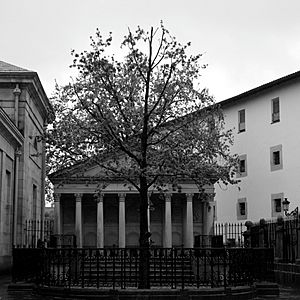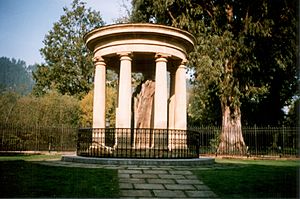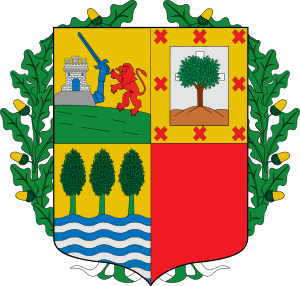Gernikako Arbola facts for kids
The Gernikako Arbola (pronounced Ger-NEE-ka-ko Ar-BOH-la) means "the Tree of Gernika" in the Basque tongue. This special oak tree is a powerful symbol of traditional freedoms for the people of Biscay and all Basque people. For centuries, important leaders, including the Lords of Biscay and even kings of Castile, promised to respect the rights of the Biscayan people under this tree. Today, the modern president of the Basque Country, called the Lehendakari, takes their oath of office there.
Contents
The Tree's History and Generations
In the Middle Ages, people from villages in Biscay would gather for important meetings under large, old trees. Over time, the main meeting place became the Guernica Assembly in 1512. The oak tree there became very important, even though the actual meetings moved to a special building built nearby (the current one is from 1833). The last Spanish ruler to swear an oath under the famous oak was Queen Maria Christina, who was ruling for her young daughter, Queen Isabella II, in 1839.
The Tree of Gernika is not just one tree, but a family of trees that have grown over centuries. Each new tree is planted from an acorn of the previous one, continuing its legacy.
Here are the different generations of the tree:
- The "Father" Tree: This tree was planted in the 1300s and lived for about 450 years.
- The "Old Tree": This tree lived from 1742 to 1892. It was replanted in 1811. You can still see its trunk preserved in a special temple in the garden today.
- The Third Tree: Planted in 1858 and replanted in 1860, this tree survived the terrible Bombing of Guernica in 1937. However, it later had to be replaced because of a fungus. Gardeners from the Biscayan government always grow several young oak trees from the acorns of the current tree, just in case.
- The Fourth Tree: This tree was planted in 1986 and replanted in the spot of its "father" on February 25, 2005. Sadly, it died from a disease in 2015.
- The Fifth Tree: The current tree was planted in March 2015, when it was 14 years old.
The Tree of Gernika became even more famous during the Carlist Wars (civil wars in Spain) as a symbol of Basque freedoms. Its importance grew worldwide among Basque people living abroad in the late 1800s and mid-1900s. This was partly thanks to the popular song "Gernikako Arbola" by Jose Maria Iparragirre.
The tree's importance was clear after the Guernica bombings. When Franco's soldiers took over the town, a group of Basque volunteers called the Tercio of Begoña protected the tree with armed guards. They stopped other soldiers, the Falangists, from cutting it down, as they wanted to destroy this symbol of Basque identity. Later, in 1950, Prince Xavier of Bourbon-Parma, who claimed the Spanish throne, also swore an oath to the Basque charters under the Oak of Guernika.
The Tree's Symbolism
The oak tree is a very important symbol in the Basque Country. You can see an oak tree on the official coat of arms of Biscay. Many towns in Biscay also feature an oak on their coats of arms. The local government of Biscay uses an oak leaf as its logo.
Even some Basque political groups use the oak in their symbols. For example, the Basque nationalist party Eusko Alkartasuna has a logo with half a red oak leaf and half a green one, matching the colors of the Basque flag. An older logo for the youth group Jarrai also showed oak leaves.
The Basque authorities often give young oak trees, grown from the acorns of the Gernika tree, as gifts. These gifts are given to Basque communities around the world and to cities that have special connections with the Basque Country. This shows friendship and shared heritage.
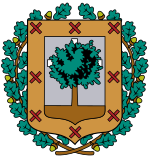 |
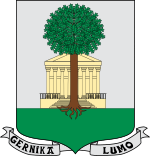 |
 |
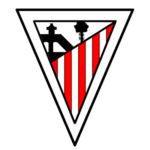 |
| Arms of Biscay | The coat of arms of Gernika-Lumo | The logo of the University of the Basque Country, with Eduardo Chillida's interpretation of the oak | An early version of football club Athletic Bilbao's crest with the tree and city icons |
Other Important Trees in Biscay
Besides the Gernika tree, other oak trees in Biscay were also important meeting places where local laws and freedoms were discussed:
- The Malato in Luiando, which was another tree with special meaning for the Basques.
- The Abellaneda oak, important for the meetings of the Encartaciones area.
- The Gerediaga oak, used for assemblies in the Durango area.
- The Aretxabalagana oak, where people from Biscay would meet their lord before he went to swear his oath under the Gernika oak.
See also
 In Spanish: Árbol de Guernica para niños
In Spanish: Árbol de Guernica para niños
- Opstalboom, a similar meeting place and symbol of freedom for the Frisian people.
- List of individual trees


